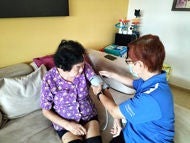What is - Urinary Incontinence

Urinary incontinence refers to an involuntary leakage of urine when it is not intended. It is a fairly common problem, and estimates show that about 60% of adult women may experience some form of urinary incontinence. 1 Urinary incontinence can affect the physical, psychological, emotional and social well-being of those affected and also cause significant stress to their caregivers and families.
Whilst urinary incontinence occurs more commonly in the elderly and in women, this is not a normal process and should not be ignored.
How does your bladder empty urine?
The lower urinary tract consists of the urinary bladder and the bladder outlet. In a healthy person, the bladder stores urine and voids at the person's convenience.During urination, the muscles in the wall of the bladder contract, emptying urine out of the bladder and into the urethra. At the same time, sphincter muscles surrounding the urethra relax, letting urine pass out of the body. Incontinence occurs if your bladder muscles contract suddenly or the sphincter muscles are not strong enough to hold back urine.
What are the types of incontinence?
There are four main types of urinary incontinence, namely stress urinary incontinence, urge urinary incontinence, overflow incontinence and mixed urinary incontinence where there is a combination of symptoms. 2
- Stress urinary incontinence (SUI)
People who experience stress urinary incontinence will have involuntary loss of urine that occurs with increases in intra-abdominal pressure, which often happens during effort or exertion. Common activities that can result in stress incontinence include sneezing, coughing, laughing, squatting, jumping, exercising or lifting heavy objects.
SUI is generally thought to be related to the lack of support of the urethra and insufficient resistance to urine outflow during times of increased abdominal pressure. Underlying mechanisms include urethral hypermobility and intrinsic sphincter deficiency.
SUI is the most common type of urinary incontinence in younger women, with the highest occurrence in women ages 45 to 49years old.3
- Urgency urinary incontinence (UUI)
Patients with UUI have an overwhelming urge to pass urine which occurs immediately before or together with the involuntary leakage of urine. These patients often experience overactive bladder symptoms as well, which is described as urgency of urination with or without incontinence, often accompanied by nocturia (frequent wakings at night to pass urine) and urinary frequency.
The underlying cause of UUI is thought to be related to detrusor (muscle of the bladder) overactivity leading to uncontrolled and involuntary detrusor muscle contractions during bladder filling resulting in urine leakage.
- Mixed urinary incontinence
This condition refers to patients who have symptoms of both stress and urgency urinary incontinence.
- Overflow urinary incontinence
Patients who experience overflow incontinence may present with urine leakage that they are not aware of, continuous leakage or dribbling of urine on a background of incomplete emptying of the bladder. Other symptoms experienced may include abnormal urinary stream, frequency and nocturia which can cause confusion with urge and stress incontinence.
Overflow urinary incontinence is usually caused by bladder outlet obstruction detrusor underactivity or a combination of both problems.
- Continuous incontinence
Patients will experience continuous and persistent leakage of urine regardless of time or activity. This may be suggestive of an underlying abnormal communication tract (fistula) between the urinary tract and the vagina resulting in continuous loss of urine through the vagina instead of the bladder.
This usually occurs in patients who have had previous pelvic surgery, tumours, infections or birth trauma but is generally a rare condition.
Risk factors for urinary incontinence?
The risk factors for urinary incontinence can be further divided based on the type of urinary incontinence as they have different underlying causes. In general, risks factors include but are not limited to:
- Increasing age
- Menopause
- Obesity
- Obstetrics history such as number of children, mode of delivery, use of instrumental delivery, birth weight, birth trauma
- Concurrent urinary tract infection
- Persistent cough
- Constipation
- Concurrent underlying medical conditions such as stroke, Parkinson’s disease, cognitive impairment, poorly controlled diabetes
- Concurrent or history of urinary tract or genital tract cancers
- Certain medications such as diuretics
- Poor mobility and manual dexterity
- Lifestyle factors such as excessive caffeine intake, alcohol, spicy and acidic foods, excessive heavy lifting
What are the complications of urinary incontinence?
Urinary incontinence may lead to several health-related complications that can impact an individual's physical and mental well-being. These include:
- Skin irritation, rashes and pressure sores due to prolonged exposure to moisture
- Recurrent urinary tract infections caused by inability to empty the bladder completely and poor hygiene
- Disrupted sleep patterns leading to fatigue and reduced function
- Increased risk of falls and injuries, particularly in older adults or those with existing mobility issues
- Worsening of pre-existing medical conditions due to restricted mobility
- Psychological stress, anxiety, depression and social isolation related to loss of bladder control
- Sexual dysfunction
- Caregiver burden and financial implications
When should you see a doctor for urinary incontinence?
You should seek medical advice if:
- your symptoms are problematic and interfering with your daily life
- there is a sudden onset of new symptoms or worsening of existing symptoms
- there is development of other concerning symptoms such as painful urination or blood in the urine.
- you experience multiple episodes of urinary tract infections
- you experience unexplained weight loss or discomfort
Do not feel embarrassed or worried to seek medical help!
What happens when you see a doctor?
Your doctor will first speak to you to obtain a thorough history. This is very important in helping to diagnose the type of urinary incontinence you experience and the underlying risk factors that may contribute to it. It will also help your doctor identify key points to formulate your treatment plan.
He or she will then proceed to perform a physical examination with the goals of diagnosing and assessing your condition. Basic and further investigations may be arranged by your doctor based on the initial assessment.
History taking
History taking involves asking you questions about your symptoms, details about your previous pregnancies, medical and surgical history and medications. Your doctor may also enquire about sexual history and how your condition may have affected your daily activities and quality of life.
Physical examination
Abdominal and pelvic examination will be performed to assess for any possible tumours, co-existing pelvic organ prolapse, strength of pelvic floor muscle contraction or signs of vaginal atrophy. An erect stress test – where you will be asked to stand on an incontinence sheet and cough about 10 times, to assess for any urinary leakage, is usually performed. If necessary, a neurological examination may also be performed.
Investigations
Further tests may be ordered after the doctor’s initial assessment.
- Bladder diary to record your fluid intake and urine output over two to three days, including work and rest days
- Urine dipstick or microscopy test to look for blood, glucose, protein, white blood cells and nitrites will be done.
- Urine cultures to exclude urinary tract infection may also be part of the initial assessment.
- Post-void residual urine volume should be measured in women who have symptoms suggesting voiding dysfunction or recurrent urinary tract infections. This may be performed using a bladder scan or catheterisation.
- For some people, urodynamics studies, a complex assessment of changes in bladder activity during filling and emptying, may be required to confirm the diagnosis and decide on treatment options, especially if surgery for urinary incontinence is considered.
Treatment for Urinary Incontinence
How is urinary incontinence treated?
Urinary incontinence can be readily treated, improved or cured with behavioural methods, medication or surgery. Management will depend on the type(s) of urinary incontinence that you experience and its severity.
Behavioural methods are simple and effective ways to control your bladder. For example, you can train your bladder to control the urge for overactive bladder; you can pass urine at certain set times to avoid overflow incontinence and you can train your pelvic floor muscles for stress incontinence.
Lifestyle modifications are often useful in improving urge incontinence, such as reducing or stopping intake of caffeinated drinks, alcohol, spicy and acidic foods.
Medicines may be used to treat urinary infection, vaginal dryness due to menopause or to reduce overactivity of bladder muscles.
Surgery is commonly considered for female stress urinary incontinence. It is offered after you have failed conservative treatment or you have severe stress urinary incontinence. Your doctor will recommend the appropriate type of surgery. Surgery may also be recommended for conditions that cause voiding difficulties such as enlarged uterus, pelvic organ prolapse or other pelvic abdominal growths.
Further details on the specific treatment options for the different types of urinary incontinence can be found in our articles for each specific condition (internal links to SUI, UUI, UTI, atrophic vaginitis)
Urinary Incontinence - Other Information
Is urinary incontinence likely to improve over time or is it a long-term condition?
The progression of urinary incontinence varies between individuals. In some cases, symptoms can be managed effectively with conservative measures such as pelvic floor exercises, bladder training and lifestyle changes. In other instances, the condition may persist and require ongoing management or additional treatment options.
What options are available if conservative measures are not effective?
If conservative measures do not provide sufficient symptom control, further treatment options may be considered. These may include medications or surgical interventions. Your doctor will perform a thorough assessment of your condition and discuss the potential treatment options with you that will best serve your needs and alleviate your symptoms. The choice of treatment will be tailored to each specific patient.
References
- Patel UL, Godecker AL, Giles DL, Brown HW. Updated prevalence of urinary incontinence in women: 2015-2018 National population-based survey data. Female pelvic med Reconstr Surg 2022;28(4):181
- Lukacz ES et al, Female urinary incontinence: Evaluation. Uptodate
- Hannestad YS, Rortveit G, Sandvik H, Hunskaar S, Norwegian EPINCONT study. A community-based epidemiological survey of female urinary incontinence: the Norwegian EPINCONT study. Epidemiology of incontinence in the county of Nord-Trøndelag.
- Urology Health. (n.d.). Urinary incontinence. https://www.urologyhealth.org/urology-a-z/u/urinary-incontinence
- Office on Women’s Health. (n.d.). Urinary incontinence. https://womenshealth.gov/a-z-topics/urinary-incontinence
- American College of Obstetricians and Gynaecologists. (n.d.). Urinary incontinence. https://www.acog.org/womens-health/faqs/urinary-incontinence
- Harvard Health Publishing. (n.d.). Types of urinary incontinence. https://www.health.harvard.edu/bladder-and-bowel/types-of-urinary-incontinence
Contributed by
The information provided is not intended as medical advice. Terms of use. Information provided by SingHealth.
Get to know our doctors at SingHealth Hospitals in Singapore.
Get to know our doctors at SingHealth Hospitals in Singapore. here.




















